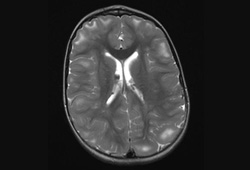Resumo
Definição
História e exame físico
Principais fatores diagnósticos
- história familiar
- epilepsia
- rabdomioma cardíaco (pode ser único ou múltiplo)
- angiomiolipomas renais
- linfangioleiomiomatose pulmonar
- nódulos subependimários calcificados cerebrais
- múltiplos tubérculos corticais e/ou linhas de migração radial
- astrocitoma de células gigantes
- angiofibromas faciais
- placa(s) cefálica(s)
- fibromas ungueais ou periungueais não traumáticos
- máculas hipomelanóticas
- marca(s) de Shagreen (nevo do tecido conjuntivo)
- hamartoma(s) nodular(es) retiniano(s)
- doença renal policística
Outros fatores diagnósticos
- numerosas depressões no esmalte dentário e fibromas intraorais
- autismo
- comprometimento cognitivo
- problemas comportamentais
- múltiplos pólipos cólicos hamartomatosos
Fatores de risco
- predisposição genética
Investigações diagnósticas
Investigações a serem consideradas
- teste genético
- ressonância nuclear magnética (RNM) cranioencefálica
- avaliação de neurodesenvolvimento
- eletroencefalograma (EEG)
- eletrocardiograma (ECG)
- ecocardiografia
- ressonância nuclear magnética (RNM) abdominal
- taxa de filtração glomerular (TFG)
- pressão arterial
- tomografia computadorizada (TC) de alta resolução do tórax
- testes de função pulmonar e teste de caminhada de 6 minutos
- radiografia esquelética
- colonoscopia
- biópsia renal
Algoritmo de tratamento
carcinoma de células renais (suspeito ou confirmado)
aneurisma intracraniano
neurológico
lesões cutâneas
renal
cardiovascular
pulmonar
cognitivo e comportamental
Colaboradores
Autores
Francis J. DiMario Jr, MD, MA, FAAP
Professor of Pediatrics and Neurology
University of Connecticut School of Medicine
Associate Chair for Academic Affairs and Faculty Development
Department of Pediatrics
Academic Chief Emeritus
Division of Pediatric Neurology
Connecticut Children's Medical Center
Hartford
CT
Declarações
FJD is an author of a number of references cited in this topic.
Revisores
Robert Robinson, MBBS, MA, MRCP, PhD
Consultant Paediatric Neurologist
Great Ormond Street Hospital
London
UK
Declarações
RR declares that he has no competing interests.
David Neal Franz, MD
Professor of Pediatrics and Neurology
Director
Tuberous Sclerosis Clinic
University of Cincinnati College of Medicine
Cincinnati Children's Hospital Medical Center
Cincinnati
OH
Declarações
DNF declares that he has no competing interests.
Créditos aos pareceristas
Os tópicos do BMJ Best Practice são constantemente atualizados, seguindo os desenvolvimentos das evidências e das diretrizes. Os pareceristas aqui listados revisaram o conteúdo pelo menos uma vez durante a história do tópico.
Declarações
As afiliações e declarações dos pareceristas referem--se ao momento da revisão.
Referências
Principais artigos
Northrup H, Aronow ME, Bebin EM, et al. Updated international tuberous sclerosis complex diagnostic criteria and surveillance and management recommendations. Pediatr Neurol. 2021 Oct;123:50-66.Texto completo Resumo
Caban C, Khan N, Hasbani DM, et al. Genetics of tuberous sclerosis complex: implications for clinical practice. Appl Clin Genet. 2016 Dec 21;10:1-8.Texto completo Resumo
Amin S, Kingswood JC, Bolton PF, et al. The UK guidelines for management and surveillance of tuberous sclerosis complex. QJM. 2019 Mar 1;112(3):171-82.Texto completo Resumo
de Vries PJ, Whittemore VH, Leclezio L, et al. Tuberous sclerosis associated neuropsychiatric disorders (TAND) and the TAND Checklist. Pediatr Neurol. 2015 Jan;52(1):25-35.Texto completo Resumo
Li M, Zhou Y, Chen C, et al. Efficacy and safety of mTOR inhibitors (rapamycin and its analogues) for tuberous sclerosis complex: a meta-analysis. Orphanet J Rare Dis. 2019 Feb 13;14(1):39.Texto completo Resumo
Artigos de referência
Uma lista completa das fontes referenciadas neste tópico está disponível para os usuários com acesso total ao BMJ Best Practice.

Diagnósticos diferenciais
- Heterotopia nodular periventricular (HNP)
- Neoplasia endócrina múltipla tipo 1 (NEM-1)
- Síndrome de Birt-Hogg-Dubé
Mais Diagnósticos diferenciaisDiretrizes
- Updated international tuberous sclerosis complex diagnostic criteria and surveillance and management recommendations
- Updated international tuberous sclerosis complex diagnostic criteria and surveillance and management recommendations
Mais DiretrizesConectar-se ou assinar para acessar todo o BMJ Best Practice
O uso deste conteúdo está sujeito ao nosso aviso legal